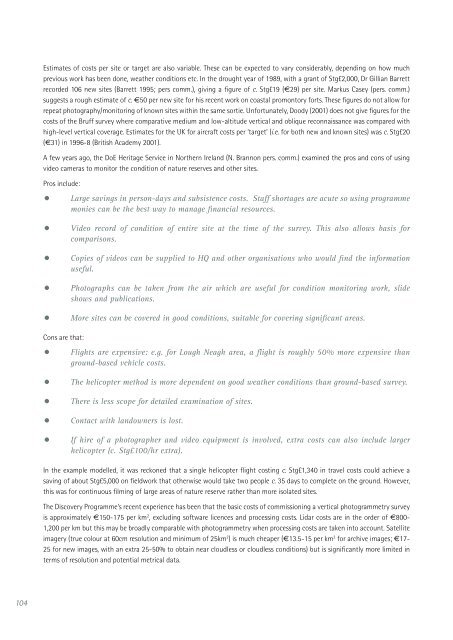Aerial Archaeology in Ireland - The Heritage Council
Aerial Archaeology in Ireland - The Heritage Council
Aerial Archaeology in Ireland - The Heritage Council
You also want an ePaper? Increase the reach of your titles
YUMPU automatically turns print PDFs into web optimized ePapers that Google loves.
104<br />
Estimates of costs per site or target are also variable. <strong>The</strong>se can be expected to vary considerably, depend<strong>in</strong>g on how much<br />
previous work has been done, weather conditions etc. In the drought year of 1989, with a grant of Stg£2,000, Dr Gillian Barrett<br />
recorded 106 new sites (Barrett 1995; pers comm.), giv<strong>in</strong>g a figure of c. Stg£19 (€29) per site. Markus Casey (pers. comm.)<br />
suggests a rough estimate of c. €50 per new site for his recent work on coastal promontory forts. <strong>The</strong>se figures do not allow for<br />
repeat photography/monitor<strong>in</strong>g of known sites with<strong>in</strong> the same sortie. Unfortunately, Doody (2001) does not give figures for the<br />
costs of the Bruff survey where comparative medium and low-altitude vertical and oblique reconnaissance was compared with<br />
high-level vertical coverage. Estimates for the UK for aircraft costs per ‘target’ (i.e. for both new and known sites) was c. Stg£20<br />
(€31) <strong>in</strong> 1996-8 (British Academy 2001).<br />
A few years ago, the DoE <strong>Heritage</strong> Service <strong>in</strong> Northern <strong>Ireland</strong> (N. Brannon pers. comm.) exam<strong>in</strong>ed the pros and cons of us<strong>in</strong>g<br />
video cameras to monitor the condition of nature reserves and other sites.<br />
Pros <strong>in</strong>clude:<br />
• Large sav<strong>in</strong>gs <strong>in</strong> person-days and subsistence costs. Staff shortages are acute so us<strong>in</strong>g programme<br />
monies can be the best way to manage f<strong>in</strong>ancial resources.<br />
• Video record of condition of entire site at the time of the survey. This also allows basis for<br />
comparisons.<br />
• Copies of videos can be supplied to HQ and other organisations who would f<strong>in</strong>d the <strong>in</strong>formation<br />
useful.<br />
• Photographs can be taken from the air which are useful for condition monitor<strong>in</strong>g work, slide<br />
shows and publications.<br />
• More sites can be covered <strong>in</strong> good conditions, suitable for cover<strong>in</strong>g significant areas.<br />
Cons are that:<br />
• Flights are expensive: e.g. for Lough Neagh area, a flight is roughly 50% more expensive than<br />
ground-based vehicle costs.<br />
•<br />
•<br />
•<br />
<strong>The</strong> helicopter method is more dependent on good weather conditions than ground-based survey.<br />
<strong>The</strong>re is less scope for detailed exam<strong>in</strong>ation of sites.<br />
Contact with landowners is lost.<br />
• If hire of a photographer and video equipment is <strong>in</strong>volved, extra costs can also <strong>in</strong>clude larger<br />
helicopter (c. Stg£100/hr extra).<br />
In the example modelled, it was reckoned that a s<strong>in</strong>gle helicopter flight cost<strong>in</strong>g c. Stg£1,340 <strong>in</strong> travel costs could achieve a<br />
sav<strong>in</strong>g of about Stg£5,000 on fieldwork that otherwise would take two people c. 35 days to complete on the ground. However,<br />
this was for cont<strong>in</strong>uous film<strong>in</strong>g of large areas of nature reserve rather than more isolated sites.<br />
<strong>The</strong> Discovery Programme’s recent experience has been that the basic costs of commission<strong>in</strong>g a vertical photogrammetry survey<br />
is approximately €150-175 per km 2 , exclud<strong>in</strong>g software licences and process<strong>in</strong>g costs. Lidar costs are <strong>in</strong> the order of €800-<br />
1,200 per km but this may be broadly comparable with photogrammetry when process<strong>in</strong>g costs are taken <strong>in</strong>to account. Satellite<br />
imagery (true colour at 60cm resolution and m<strong>in</strong>imum of 25km 2 ) is much cheaper (€13.5-15 per km 2 for archive images; €17-<br />
25 for new images, with an extra 25-50% to obta<strong>in</strong> near cloudless or cloudless conditions) but is significantly more limited <strong>in</strong><br />
terms of resolution and potential metrical data.

















